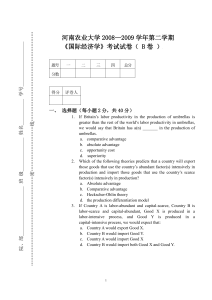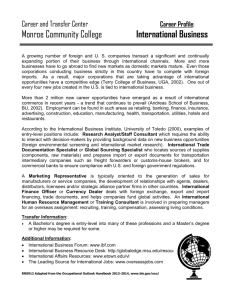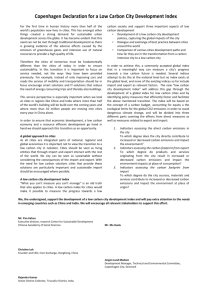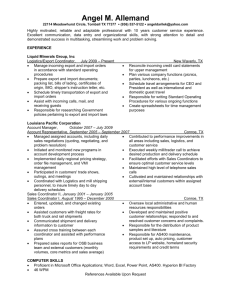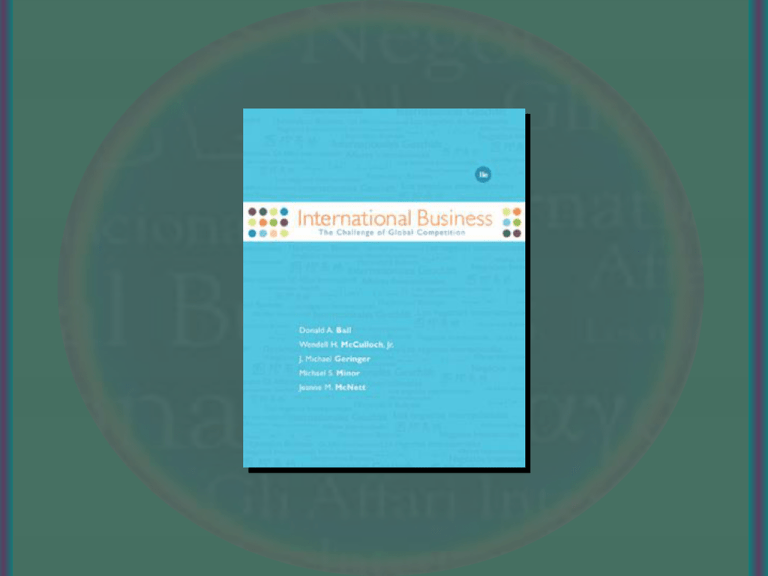
chapter three
Theories of International Trade
and Investment
McGraw-Hill/Irwin
International Business, 11/e
Copyright © 2008 The McGraw-Hill Companies, Inc. All rights reserved.
Learning Objectives
Explain the theories that attempt to explain
why certain goods are traded internationally
Discuss the arguments for imposing trade
restrictions
Explain two basic kinds of import restrictions:
tariff and nontariff trade barriers
3-3
Learning Objectives
Appreciate the relevance of changing status of
tariff and nontariff barriers to managers
Explain some of the theories of foreign direct
investment
3-4
International Trade Theory
• Mercantilism
– Economic philosophy based on belief that
• (1) a nation’s wealth depends on
accumulated treasure, usually gold, and
• (2) to increase wealth, government
policies should promote exports and
discourage imports
3-5
Theory of Absolute Advantage
• Absolute advantage
– Theory that a nation has absolute
advantage when it can produce a larger
amount of a good or service for the same
amount of inputs as can another country or
– When it can produce the same amount of a
good or service using fewer inputs than
could another country
3-6
Absolute Advantage
Example
Each Country Specializes
3-7
Absolute Advantage
Terms of Trade (Ratio of International Prices)
Gains from Specialization and Trade
3-8
Theory of Comparative Advantage
• Comparative Advantage
– A nation having absolute disadvantages in
the production of two goods with respect to
another nation has a comparative or relative
advantage in the production of the good in
which its absolute disadvantage is less
3-9
Theory of Comparative Advantage
Example
Each Country Specializes
3-10
Comparative Advantage
Terms of Trade – at a rate of ¾ bolt of cloth for 1 ton of soybeans
Terms of Trade – at a rate of 1 bolt of cloth for 1 ton of soybeans
Gains from Specialization and Trade
3-11
Heckscher-Ohlin Theory of Factor
Endowment
• Factor Endowment
– Heckscher-Ohlin theory that countries
export products requiring large amounts of
their abundant factors of production and
import products requiring large amounts of
their scarce factors of production
– Remember that a factor of production is
land, labor, capital, and raw materials
3-12
Heckscher-Ohlin Theory of Factor
Endowment
• Leontief Paradox
Some countries like the United States, one
of the most capital-intensive countries in the
world, were not following the factor
endowment theory and were like the US
exporting relatively labor-intensive products
in exchange for relatively capital-intensive
products
3-13
How Can Money Change The
Direction of Trade?
Exchange Rate – the price of one currency stated in terms of
another currency
The exchange rate can change: If the other country’s currency is
depreciated, then we have more trouble selling to them as our
products are relatively more expensive (relative to what they were
before or relative to what the product costs in the rest of the
world).
If the other country’s currency is appreciated, then our goods
are relatively cheaper and they can buy more.
3-14
How Can Money Change The
Direction of Trade?
• Influences of Exchange Rate
– Currency devaluation
• The lowering of a currency’s price in
terms of other currencies
3-15
Some Newer Explanations For The
Direction Of Trade
• Linder Theory of Overlapping Demand
– Customers’ tastes are strongly affected by
income levels; therefore a nation’s income
per capita level determines the kinds of
goods they will demand
3-16
Some Newer Explanations For The
Direction Of Trade
• International Product Life Cycle (IPLC)
– Explains why a product that begins as
export eventually becomes import (figure
3.2)
• U.S. exports
• Foreign production begins
• Foreign competition in export market
• Import competition in the United States
3-17
Figure 3.2 International Product Life
Cycle
3-18
Some Newer Explanations For The
Direction Of Trade
• Economies of Scale and Experience Curve
– As a plant gets larger and output increase, the
average cost of producing each unit of output
decreases
– As firms produce more products, they learn ways to
improve production efficiency
3-19
Some Newer Explanations For The
Direction Of Trade
• Imperfect Competition
– Economies of scale with the existence of
differentiated products--Paul Krugman
• First-Mover Theory
– Pattern of trade in goods subject to scale
economies may be determined by historical
factors
3-20
Trade Restrictions: Arguments For
•
•
•
•
National Defense
Sanctions to Punish Offending Nations
Protect Infant (or Dying) Industry
Protect Domestic Jobs from Cheap
Foreign Labor
• Scientific Tariff or Fair Competition
3-21
Trade Restrictions
• Retaliation
– Dumping: selling a product abroad for less
than the cost of production, the price in the
home market, or the price to third countries
• Social dumping
• Environmental dumping
• Financial services dumping
• Cultural dumping
• Tax dumping
3-22
Trade Restrictions
– Subsidies: Financial contributions, provided
directly or indirectly by a government, which
confer a benefit; include grants, preferential
tax treatment, and government assumption
of normal business expenses (figure 3.4)
– Countervailing duties: Additional import
taxes levied on imports that have benefited
from export subsidies
3-23
Tariff Barriers
• Tariff
– Taxes on imported goods for the purpose of raising
their price to reduce competition for local producers
or stimulate local production
• Ad Valorem Duty
– An import duty levied as a percentage of the
invoice value of imported goods
• Specific Duty
– A fixed sum levied on a physical unit of an imported
good
3-24
Tariff Barriers
• Compound Duty
– A combination of specific and ad valorem duties
• Official Prices
• Variable Levy
– An import duty set at the difference between world
market prices and local government-supported
prices (World market prices lower so they are taxed
enough to make them level with local prices)
• Lower Duty for more local Input
3-25
Nontariff Barriers
• Nontariff barriers (NTBs)
– All forms of discrimination against imports
other than import duties
• Quantitative
– Quotas: numerical limits placed on specific
classes of imports
– Voluntary export restraints (VERs): Export
quotas imposed by exporting nation
3-26
Nontariff Barriers
• Orderly Marketing Arrangements
– Formal agreements between exporting and
importing countries that stipulate the import
or export quotas each nation will have for a
good
• Nonquantitative Nontariff Barriers
– Direct government participation in trade
– Customs and other administrative
procedures
– Standards
3-27
International Investment Theories
• Monopolistic Advantage Theory
Theory that FDI is made by firms in oligopolistic
industries possessing technical and other advantages
over indigenous firms
• Product and Factor Market Imperfections
Superior knowledge leads to differentiated products,
and they lead to firm control on price and advantage
over indigenous firm (Hymer and Caves)
• Financial Factors
Imperfections in the foreign exchange markets (Aliber)
• International Product Life Cycle
3-28
International Investment Theories
• Follow The Leader
• Cross Investment
– Foreign direct investment by oligopolistic
firms in each other’s home countries as a
defense measure
3-29
International Investment Theories
• Dynamic Capabilities
– Theory that for a firm to successfully invest
overseas, it must have ownership of unique
knowledge or resources and the ability to
dynamically create and exploit these capabilities
• Dunning’s Eclectic Theory Of International
Production
– Theory that for a firm to invest overseas, it must
have three kinds of advantages: ownershipspecific, internalization, and location-specific
3-30


